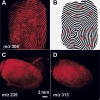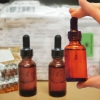Articles
Molecular imaging by mass spectrometry: application to forensics
After an introduction to MALDI, DESI and SIMS, the authors describe their main applications in forensics, as well as the advantages provided in terms of sample preparation over approaches routinely used in toxicological laboratories.
The EPSRC National Mass Spectrometry Service Centre at Swansea
Tony (A.N.) Davies is impressed with the service form the UK's EPSRC National Mass Spectrometry Service Centre.
Clinical mass spectrometry: a short review
Applications of mass spectrometry in the clinical area have increased significantly in recent years and continue to expand. The complexity of analyses has also increased, with work being undertaken in clinical labs that would have been the reserve of research labs a few years ago.
Investigation of spacecraft outgassing by sensitive mass spectrometry
M. Hässig,a K. Altwegg,a H. Balsiger,a B. Schläppi,a J.J. Berthelier,b B. Fiethe,c S.A. Fuselier,d J. De Keysere and M. Rubinf
aPhysikalisches Institut, University of Bern, Sidlerstr. 5, CH-3012 Bern, Switzerland
bLATMOS, Saint Maur, France
cInstitut of Computer and Network Engineering, Technische Universität Braunschweig, Germany
Targeting new performance enhancing drugs in doping controls: Selective androgen receptor modulators (SARMs)
Doping control authorities and sports drug testing laboratories are frequently confronted with the illicit use of performance-enhancing therapeutics and therefore various analytical strategies have been developed to detect a misused drug and/or its metabolic product(s) in blood or urine specimens. Besides the administration of clinically approved drugs prohibited in sports, new drug candidates currently undergoing early or advanced clinical trials have also been the subject of investigations concerning their prevalence and abuse by athletes.
Selected ion flow tube mass spectrometry, SIFT-MS; new horizons in real time air and breath analysis
We conceive selected ion flow tube mass spectrometry, SIFT-MS, primarily as a real-time, absolute, analytical technique that can meet the challenge of the immediate analysis of humid exhaled breath for rapid clinical diagnosis and therapeutic monitoring. This objective has certainly been achieved and the application of SIFT-MS has quickly been expanded into many other areas where real time, immediate analyses of trace compounds in air are desired, as we have demonstrated in recent reviews and which we summarise at the end of this article.
ZooMS: the collagen barcode and fingerprints
This year the International Barcode of Life initiative (IBoL) plans to begin an ambitious programme to barcode the DNA of more than five million specimens representing at least 500,000 species in five years. Molecular barcodes exploit the fact that molecular sequences offer an independent method to identify a sample. Such molecular barcodes have widespread application in systematics, biodiversity, forensics and even food science. Molecular barcodes tend to be based upon DNA, which with the advent of new technologies offers a fast and efficient means of identification. Proteins too have been used in the past for molecular identification, most commonly exploiting the exquisite specificity of antibodies to discriminate targeted proteins. Recently the idea of using protein mass spectrometry to fingerprint samples has been used to target samples in which processing or decay has destroyed the DNA.
Natural rubber latex gloves: identifying and localising allergens applying mass spectrometric methods
This article shows that MALDI high resolution mass spectrometry demonstrated directly that Hev b 6 and Hev b 1, and also truncated forms thereof, are present on the inner surface of medical NRL gloves. The speed and high accuracy of the applied method and instrumentation makes the detection of surface associated proteins feasible without any prior protein extraction procedure (in situ localisation).
Species origin identification of Oetzi's clothing by MALDI-ToF mass spectrometry using tryptic hair digests
In 2007 we introduced our method in Spectroscopy Europe describing the identification of furs by hair digest based matrix-assisted laser desorption/ionisation time of flight (MALDI-ToF) mass spectrometry (MS). This so-called SIAM (Species Identification of Animals) method can also be used for the species determination of ancient furs.
Mass spectrometry in Africa and its role in environmental monitoring and the preservation of endangered species
The Foundation for Analytical Science & Technology in Africa (FASTA) is a charitable company that was established in 2005 in response to a request to provide a GC-MS to the Jomo Kenyatta University of Agriculture & Technology (JKUAT) in Nairobi, Kenya. FASTA was founded by Steve Lancaster of BP and Barrie Nixon of Mass Spec UK Ltd. The objectives of the organisation are to support scientific education, analytical research and the preservation of the environment in Africa via capacity-building and technology transfer.
The role of MALDI-enabled linear ion trap mass spectrometry as a sensitive tool in tissue imaging
This article discusses matrix-assisted laser desorption/ionisation (MALDI) enabled linear ion trap (LIT) mass spectrometry (MS) as a technique for fast and accurate tissue imaging, compared to the more traditional time-of-flight (ToF) method.
Mass spectrometric analysis of supramolecular host-guest complexes
During the last few decades, solution and solid state techniques have been utilised to obtain information about the properties of supramolecular host–guest complexes. Mass spectrometric analysis of these fragile non-covalent complexes has been focused on the determination of the molecular mass of the interacting molecules and the analysis has concentrated on the characterisation of covalent compounds. Since the invention of the soft ionisation techniques [namely ESI (electospray ionisation) and MALDI (matrix-assisted laser desorption/ionisation)] and their development for mass spectrometry (MS) instruments, the area and way that MS analysis is used have greatly changed and expanded. In particular, ESI has attained a steady position for the analysis of biomolecules, their non-covalent complexes and other rather fragile systems, which were earlier impossible to study by mass spectrometric methods. Today, MS can be employed not only for molecular weight identification purposes but also for sophisticated analyses on versatile properties of compounds. In the area of supramolecular chemistry, MS studies are becoming more and more general, although MS utilisation is still quite limited.
Identification and quantitation of proteins using mass spectrometry-based peptide multiplex labelling methods
The effectiveness of these new reagents in quantitating eight states simultaneously has been determined against a set of known peptides and proteins, and is outlined in this article. The reagents were evaluated for label efficiency, fragmentation efficiency and precision and accuracy of quantitation.
Detecting illicit drugs and metabolites in wastewater using high performance liquid chromatography-tandem mass spectrometry
We will consider here the analytical aspects involved in the measurements of illicit drugs and their metabolites in wastewater samples by HPLC-MS/MS.
Identification of furs of domestic dog, raccoon dog, rabbit and domestic cat by hair analysis using MALDI-ToF mass spectrometry
The authors show how the use of SIAM method (Species Identification of Animals MALDI-TOF mass spectrometry) is a fast and reliable tool for recognising the origin of mammalian species.
Drug tablets instant analysis by desorption-electrospray ionisation mass spectrometry
Luc Alexis Leuthold, Emmanuel Varesio and Gérard Hopfgartner
Life Sciences Mass Spectrometry, School of Pharmaceutical Sciences, EPGL, University of Geneva, University of Lausanne, 20 Bd d’Yvoy, 1211 Geneva 4, Switzerland
Laser desorption and laser ablation Fourier transform mass spectrometry for the analysis of pollutants in complex matrices
Frédéric Aubriet,* Vincent Carréa and Jean-François Muller
Laboratoire de Spectrométrie de Masse et de Chimie Laser, Université Paul Verlaine–Metz, 1, Boulevard Arago, F-57078 Metz Technopole 2000 Cedex 03, France. E-mail: [email protected]
aPresent address: UMR CNRS 8522, Physicochimie des Processus de Combustion et de l’Atmosphère, LCPA–Université d’Artois, Parc Porte Nord, 62700 Bruay-la-Buissière, France
Drugs on money and beyond: tandem mass spectrometry in the forensic sciences
Rich Sleeman, Jim Carter and Karl Ebejer
Mass Spec Analytical Ltd, Building 20F, Golf Course Lane, Filton, Bristol, BS99 7AR, UK
Detecting nitrofuran metabolites in animal products using LC/MS/MS
Lutz Hartiga and Kristin von Czapiewskib
aEurofins, Wiertz-Eggert-Jörissen GmbH, Stenzelring 14b, 21107 Hamburg, Germany
bApplied Biosystems, Applera Deutschland GmbH, Franfurter Straße 129 B, 64293 Darmstadt, Germany
Breath analysis for medical diagnosis and therapeutic monitoring
Anton Amann,a,d Alex Schmid,a,b Sabine Scholl-Bürgi,c Stefan Telserb and Hartmann Hinterhuberb
aDepartment of Anesthesia and General Intensive Care, Innsbruck Medical University, A-6020 Innsbruck, Austria
bDepartment of Psychiatry, Sleep Laboratory, Innsbruck Medical University, A-6020 Innsbruck, Austria
cClinical Department of General Paediatrics, Innsbruck Medical University, A-6020 Innsbruck, Austria







